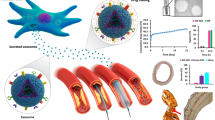Summary
Paclitaxel, a potent anti-tumor agent, shifts the cytoskeleton equilibrium towards assembly of altered and extraordinarily stable microtubules. These cellular modifications lead to reduced proliferation, migration, and signal transduction. It is highly lipophilic, which promotes a rapid cellular uptake, and has a long-lasting effect in the cell due to the structural alteration of the cytoskeleton. This makes paclitaxel a promising candidate for local drug delivery intended to address the proliferative and migratory processes involved in restenosis. In this article, results of our in vitro and in vivo studies with paclitaxel are presented. Cell culture experiments with monocultures of human arterial smooth muscle cells as well as cocultures with human endothelial cells showed that paclitaxel leads to an almost complete growth inhibition within a dose range of 1.0–10.0μmol/l, even after a short (20 min) single dose application. The comparison of an active, semi-active, and passive delivery system (porous balloon, microporous balloon, and double balloon) favored the double balloon for the following in vivo experiments. Tubulin staining and electron microscopy enabled visualization of paclitaxel-induced vessel wall alterations. In the rabbit model, locally delivered paclitaxel resulted in reduced neointima formation and enlargement in vessel size; in the pig model, however, after stenting, this inhibition was not significant. Both reduced proliferation and enlargement in vessel size contribute to a preservation of vessel shape and are likely to be caused by a structural alteration of the cytoskeleton, which is also supported by vascular contraction force experiments.
Zusammenfassung
Paclitaxel, eine sehr potente antiproliferative Substanz, fördert die Bildung ungewöhnlich stabiler und funktionsgestörter Mikrotubuli und verändert dadurch zelluläre Mechanismen, die letztlich zu verminderter Proliferation, Migration und Signaltransduktion führen. Paclitaxel ist lipophil, was eine rasche Aufnahme in die Zelle fördert, und hat einen langanhaltenden Effekt in der Zelle aufgrund der strukturellen Veränderung des Zytoskelettes. Diese Eigenschaften machen Paclitaxel zu einem vielversprechenden Kandidaten für die lokale Medikamentenapplikation zur Restenoseprophylaxe. In dieser Arbeit werden die in-vitro und in-vivo Ergebnisse aus unseren Forschungsarbeiten zu Paclitaxel vorgestellt. Zellkulturexperimente mit Monokulturen von humanen glatten Gefäßmuskelzellen sowie mit Co-Kulturen mit humanen Endothelzellen zeigten, daß Paclitaxel in einem Dosisbereich zwischen 1,0 und 10,0μmol/l zu einer beinahe vollständigen Wachstumshemmung, selbst nach kurzer (20 min.) Einmalapplikation führt. Nach Vergleich von 3 verschiedenen Kathetersystemen (poröser Ballon, mikroporöser Ballon und Doppelballon) wurde der Doppelballon für die in-vivo Anwendung favorisiert. Anhand von Anfärbungen des Zytoskelettes sowie elektronenoptisch gelang der Nachweis der Paclitaxelwirkung in den glatten Muskelzellen der Gefäßwand. Im Kaninchen führte lokal appliziertes Paclitaxel zu einer signifikanten Hemmung der neointimalen Proliferation und Erweiterung des Gefäßdurchmessers im Vergleich zu ballondilatierten Kontrolltieren. In Zusatzexperimenten konnte eine drastische Verringerung der vaskulären Kontraktionskraft nach Paclitaxelgabe gezeigt werden. Ähnlich eindeutige Ergebnisse fanden sich nach Stentimplantation im Schweinemodell nicht.
Similar content being viewed by others
Author information
Authors and Affiliations
Additional information
Eingegangen: 14. Juli 1999/Akzeptiert: 11. November 1999
Rights and permissions
About this article
Cite this article
Herdeg, C., Oberhoff, M., Siegel-Axel, D.I. et al. Paclitaxel: Ein Chemotherapeutikum zur Restenoseprophylaxe? Experimentelle Untersuchungen in vitro und in vivo. Z Kardiol 89, 390–397 (2000). https://doi.org/10.1007/s003920050503
Issue Date:
DOI: https://doi.org/10.1007/s003920050503




